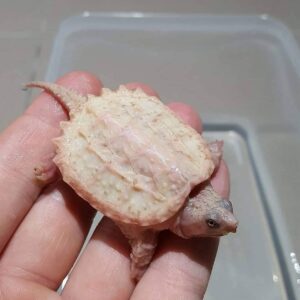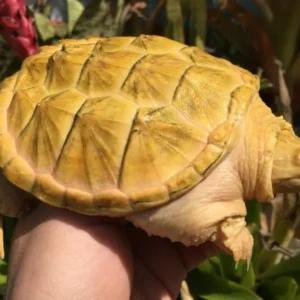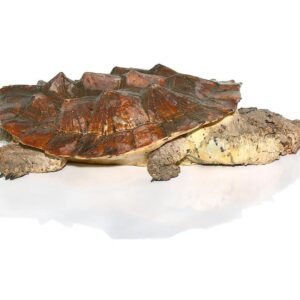C.B. Adult Indonesian Snake-Necked Turtle For Sale
$449.99
WE HAVE ADULT INDONESIAN SNAKE-NECKED TURTLE FOR SALE. HERE ARE SOME HIGHLIGHTS:
- Chelodina siebenrocki
- Captive Bred Male
- Approximately 6 – 8 Inches In Shell Length
- Can Grow Up To 14 Inches
- Fascinating To Watch Swim & Feed On Blood Worms, Silversides, Turtle Pellets, And Shrimp
FUN FACTS!
- Amazing Creatures Displaying Long Pale Necks Able To Reach The Waters Surface
- Originating From Indonesia; Papua New Guinea Near Coastal Swamps And Offshore Islands
- These Are Beautiful Turtles That Have Stunning Color On Its Body, Combined With Unique Patterns On Its Shell, That Are Coming To You With A Smile
Description
The Indonesian Snake-Necked Turtle, scientifically known as Chelodina mccordi, stands out as one of the most unique and intriguing members of the turtle family. Belonging to the family Chelidae, this species is particularly noteworthy for its long, slender neck that can often rival the length of its shell. This distinctive feature not only sets it apart from other turtles but also contributes to its common name, “snake-necked turtle.”
Originating from the Indonesian islands, particularly Rote Island, this turtle exhibits a range of fascinating physical traits. Its carapace, or upper shell, tends to be more oval-shaped and displays a variety of patterns and hues that can range from dark brown to olive. The plastron, or lower shell, typically contrasts with lighter shades, often showcasing intricate designs that add to its unique appearance. These patterns and colors provide excellent camouflage in their natural habitat, aiding in their survival.
In addition to its elongated neck, the Indonesian Snake-Necked Turtle has other distinguishing characteristics. Its limbs are robust and webbed, facilitating efficient swimming and maneuvering through water. The turtle’s head, although small in comparison to its neck, is adorned with sharp, keen eyes that enhance its ability to hunt and forage. The combination of these physical traits enables the Indonesian Snake-Necked Turtle to adapt and thrive in its environment, making it a fascinating subject of study for herpetologists and nature enthusiasts alike.
Understanding the taxonomy and general characteristics of the Indonesian Snake-Necked Turtle sets the foundation for a deeper exploration into its behavior, habitat, and conservation status. This introductory overview highlights the remarkable features that make this species a standout in the diverse world of reptiles, paving the way for a comprehensive appreciation of its ecological significance.
The Indonesian Snake-Necked Turtle, known scientifically as Chelodina mccordi, is predominantly found in the aquatic ecosystems of Indonesia. This unique species thrives in a variety of freshwater habitats, which include rivers, swamps, and lakes. These environments provide the essential resources needed for their survival, such as ample food supply and suitable conditions for breeding and nesting.
Freshwater rivers are a primary habitat for the Indonesian Snake-Necked Turtle. These turtles are often observed in slow-moving rivers where the water is relatively calm. Such conditions are ideal as they offer abundant plant life, which provides both food and shelter. Swamps also serve as a significant habitat. These wetlands, characterized by saturated soils and dense vegetation, create a perfect environment for these turtles to forage and hide from predators.
Lakes, particularly those with rich aquatic vegetation and soft, muddy bottoms, are another critical habitat for the Indonesian Snake-Necked Turtle. The still waters of lakes enable these turtles to swim and hunt efficiently. Moreover, the presence of submerged logs and other debris provides excellent basking and hiding spots. These elements are crucial for their thermoregulation and protection from potential threats.
Geographically, the Indonesian Snake-Necked Turtle is mainly distributed within the Indonesian archipelago. The island of Roti, located in the eastern part of Indonesia, is known to be a significant stronghold for this species. Other regions within the islands of Timor and Flores also report sightings, indicating the species’ presence in various parts of the country. The localized distribution of these turtles highlights the importance of specific environmental conditions that support their existence.
Understanding the habitat and distribution of the Indonesian Snake-Necked Turtle is vital for conservation efforts. Protecting these freshwater ecosystems ensures the survival of this unique species, which plays an important role in maintaining the ecological balance within their natural habitats.
Physical Characteristics and Adaptations
The Indonesian Snake-Necked Turtle, known scientifically as Chelodina mccordi, is distinguished by its remarkable physical traits, most notably its elongated neck. This unique feature can sometimes be as long as the turtle’s carapace, setting it apart from other turtle species. The long neck serves a crucial role in its predatory habits, allowing the turtle to strike swiftly at prey from a considerable distance, thus optimizing hunting efficiency.
The carapace, or upper shell, of the Indonesian Snake-Necked Turtle is another distinctive physical characteristic. It is generally oval-shaped and slightly domed, providing both protection and streamlined movement through aquatic environments. The coloration of the carapace varies, ranging from dark brown to a subdued olive hue, which aids in camouflage among the murky waters and dense vegetation of its natural habitat.
Evolution has equipped the Indonesian Snake-Necked Turtle with several adaptations that enhance its survival. One of the most noteworthy is its retractable neck. Unlike many other turtles that retract their heads straight back into their shells, this species bends its long neck sideways, folding it along the side of the body. This unique adaptation not only protects the neck from predators but also allows the turtle to fit into tighter hiding spaces.
Another significant adaptation is the turtle’s specialized diet. The Indonesian Snake-Necked Turtle primarily feeds on small fish, amphibians, and aquatic invertebrates. Its sharp, hooked beak is designed for grasping and tearing prey, making it an effective hunter in its environment. Additionally, the long neck, combined with rapid head movement, enables it to catch fast-moving prey with precision.
In summary, the Indonesian Snake-Necked Turtle’s physical characteristics and evolutionary adaptations are fascinating examples of nature’s ingenuity. Its long neck, unique shell structure, and specialized diet are all integral to its survival, showcasing the remarkable ways in which this species has evolved to thrive in its specific ecological niche.
Diet and Feeding Habits
The Indonesian Snake-Necked Turtle, scientifically known as Chelodina mccordi, exhibits a diverse and adaptable diet primarily driven by its aquatic environment. These turtles are carnivorous, predominantly preying on small fish, amphibians, and various invertebrates such as insects and crustaceans. Their elongated necks play a crucial role in their hunting strategy, enabling them to strike swiftly at unsuspecting prey. This unique anatomical adaptation allows them to extend their reach significantly, compensating for their relatively slow swimming speed.
In their natural habitat, Indonesian Snake-Necked Turtles demonstrate opportunistic feeding behaviors, adjusting their diet based on the availability of food sources. During the wet season, when aquatic life flourishes, they have access to a more abundant and varied selection of prey. Conversely, in the dry season, they may resort to consuming more terrestrial insects and even carrion when aquatic prey becomes scarce. This flexibility in their diet is vital for their survival, showcasing their remarkable adaptability to changing environmental conditions.
Interestingly, these turtles exhibit a combination of both active hunting and ambush tactics. While they actively forage for food, they also utilize a sit-and-wait approach, remaining motionless and camouflaged among aquatic vegetation until a potential meal comes within striking distance. This dual strategy maximizes their efficiency in capturing prey, ensuring they can sustain themselves even in less favorable conditions.
Another notable feeding adaptation of the Indonesian Snake-Necked Turtle is its ability to feed underwater. Unlike many other turtle species that need to surface to swallow, these turtles can consume their prey entirely submerged, thanks to specialized structures in their throats that prevent water from entering their respiratory system while feeding. This adaptation not only aids in their hunting success but also reduces their vulnerability to predators during feeding.
Behavior and Social Structure
The Indonesian Snake-Necked Turtle exhibits a range of fascinating behaviors that provide insight into its daily activities and social interactions. These turtles are primarily aquatic, spending the majority of their time in freshwater environments such as rivers, swamps, and lakes. Their daily activities revolve around foraging for food, basking, and seeking shelter to avoid predators. They are opportunistic feeders, consuming a diet that includes fish, insects, crustaceans, and plant material.
Social interactions among the Indonesian Snake-Necked Turtle are relatively limited, as these reptiles are generally solitary creatures. However, during the breeding season, their behavior changes markedly. Mating rituals are intricate and involve a series of visual and tactile signals. Males often engage in a display of head bobbing and neck stretching to attract females. Once a female is receptive, mating occurs in the water, and the female later lays eggs on land, typically in a concealed location to protect them from predators.
Territoriality is another notable aspect of their behavior. While not overly aggressive, Indonesian Snake-Necked Turtles can exhibit territorial behaviors, especially during the breeding season. Males may become more assertive in defending their chosen breeding areas from rivals. These interactions are usually resolved through displays rather than physical confrontations, involving posturing and movements intended to intimidate potential intruders.
Researchers have also observed several unique behavioral traits in the Indonesian Snake-Necked Turtle. One such trait is their ability to retract their head sideways into their shell, rather than pulling it directly back. This distinctive behavior not only provides a defensive mechanism but also aids in their streamlined movement through the water. Additionally, these turtles have a keen sense of their environment, often utilizing specific landmarks and water currents to navigate their habitats effectively.
Overall, the behavioral patterns of the Indonesian Snake-Necked Turtle are complex and multifaceted, reflecting their adaptability and resilience in diverse aquatic ecosystems. Their solitary nature, intricate mating rituals, and unique defensive mechanisms highlight the remarkable adaptations that have enabled them to thrive in their natural habitats.
Conservation Status and Threats
The Indonesian Snake-Necked Turtle (Chelodina mccordi) is currently classified as Critically Endangered on the IUCN Red List. This alarming status underscores the urgent need for comprehensive conservation measures to protect this unique species. Several factors contribute to the declining population of the Indonesian Snake-Necked Turtle, with habitat destruction being one of the most significant threats. The rapid conversion of wetlands and forests into agricultural land and urban areas has led to a substantial loss of the turtle’s natural habitat, severely impacting its population.
Pollution also poses a grave threat to the survival of the Indonesian Snake-Necked Turtle. Contaminants such as pesticides, heavy metals, and plastic waste infiltrate water bodies, degrading the quality of the turtle’s habitat and affecting their health and reproductive success. Additionally, human activities, such as the illegal pet trade and over-collection for traditional medicine, further exacerbate the decline in their numbers. The high demand for these turtles in international markets has led to unsustainable harvesting practices, pushing the species closer to extinction.
In response to these threats, various conservation efforts and initiatives have been implemented to protect and preserve the Indonesian Snake-Necked Turtle. Local and international organizations are working collaboratively to establish protected areas and restore degraded habitats. These initiatives aim to create safe environments where the turtles can thrive and reproduce without the pressures of human interference. Educational programs and awareness campaigns are also crucial components of conservation strategies, as they help to inform and engage local communities about the importance of preserving this unique species.
Moreover, captive breeding programs have been established to bolster the population of the Indonesian Snake-Necked Turtle. These programs aim to breed turtles in controlled environments and eventually reintroduce them into their natural habitats. Collaboration between governments, conservation organizations, and local communities is essential for the success of these initiatives. Through concerted efforts, there is hope that the Indonesian Snake-Necked Turtle can be saved from the brink of extinction, ensuring its survival for future generations.
Captive Care and Husbandry
For those fascinated by the Indonesian Snake-Necked Turtle and considering them as pets, it is crucial to understand the specific requirements for their care and husbandry. Ensuring that their environment closely mimics their natural habitat is vital for their health and well-being.
The tank setup is fundamental. A spacious aquarium, preferably a minimum of 75 gallons for a single turtle, is recommended. These turtles require both water and land areas, with the water section taking up the majority of the space. The water depth should be adequate for swimming, ideally around 12-18 inches, and the land area should be large enough for basking. A basking platform can be created using smooth rocks or commercial basking docks.
Maintaining water quality is another critical aspect. The water should be filtered continuously to keep it clean and free from harmful bacteria. Regular water changes, approximately 25-30% every two weeks, are necessary to maintain the optimal environment. The water temperature should be kept between 75-82°F, and a submersible heater can help achieve this. Additionally, UVB lighting is essential for the turtle’s shell health and overall vitality, simulating natural sunlight.
Diet is a key component of the Indonesian Snake-Necked Turtle’s care. They are omnivorous and their diet in captivity should include a variety of foods. Offering a mix of aquatic plants, fish, insects, and commercially available turtle pellets can ensure they receive balanced nutrition. Calcium supplements are also beneficial, particularly for shell development.
Health care for these turtles involves routine check-ups and monitoring for signs of illness. Common health issues include shell rot, respiratory infections, and parasitic infestations. Quarantine new additions to the tank to prevent the spread of disease, and consult a reptile veterinarian if any symptoms arise.
In summary, proper care and husbandry of the Indonesian Snake-Necked Turtle involve meticulous attention to their environment, diet, and health. By replicating their natural habitat as closely as possible, enthusiasts can ensure these unique creatures thrive in captivity.
Interesting Facts and Trivia
The Indonesian Snake-Necked Turtle, scientifically known as Chelodina mccordi, is a unique species that captivates both researchers and enthusiasts alike. One of the most striking features of this turtle is its elongated neck, which can be as long as, or even longer than, its carapace. This adaptation allows the turtle to extend its head rapidly to catch prey, making it a formidable predator in its aquatic habitat.
Interestingly, these turtles exhibit a behavior known as “neck-tucking,” where they fold their neck sideways under their shell rather than retracting it directly backward like most other turtles. This distinctive trait is not just fascinating but also serves as an effective defense mechanism against potential predators.
From a biological standpoint, the Indonesian Snake-Necked Turtle’s diet is diverse, consisting mainly of small fish, crustaceans, and aquatic insects. Their sharp, beak-like jaws are perfectly adapted for slicing through the exoskeletons of their prey. In their native habitats, which include slow-moving rivers, swamps, and freshwater lakes, they play a crucial role in maintaining ecological balance by controlling the population of these smaller aquatic creatures.
The cultural significance of the Indonesian Snake-Necked Turtle cannot be overlooked. In some Indonesian communities, these turtles are considered symbols of longevity and resilience, often featured in local folklore and traditional art. They are also an essential aspect of the local biodiversity, highlighting the rich natural heritage of Indonesia.
Despite their ecological importance, the Indonesian Snake-Necked Turtle faces significant threats, primarily due to habitat destruction and the illegal pet trade. Conservation efforts are underway to protect these unique reptiles, emphasizing the need for sustainable practices and legal frameworks to ensure their survival.
In essence, the Indonesian Snake-Necked Turtle is not just a marvel of evolution but also a critical component of its ecosystem and a symbol of Indonesia’s rich natural and cultural diversity.





